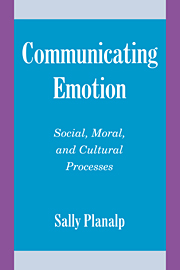Book contents
- Frontmatter
- Dedication
- Contents
- Acknowledgments
- Introduction
- 1 How Important Is Emotion in Everyday Interaction?
- 2 How and Why Is Emotion Communicated?
- 3 Is Emotional Communication Spontaneous or Strategic?
- 4 How Is Emotional Meaning Constructed Through Communication?
- 5 How Is Emotional Meaning Both Personal and Social?
- 6 How Do Emotion Messages Communicate Moral Meaning?
- 7 How Is Emotional Communication Grounded in Common Human Experience and Diverse Cultures?
- Epilogue: What is the Future of Emotional Meaning?
- References
- Author Index
- Subject Index
4 - How Is Emotional Meaning Constructed Through Communication?
Published online by Cambridge University Press: 05 February 2015
- Frontmatter
- Dedication
- Contents
- Acknowledgments
- Introduction
- 1 How Important Is Emotion in Everyday Interaction?
- 2 How and Why Is Emotion Communicated?
- 3 Is Emotional Communication Spontaneous or Strategic?
- 4 How Is Emotional Meaning Constructed Through Communication?
- 5 How Is Emotional Meaning Both Personal and Social?
- 6 How Do Emotion Messages Communicate Moral Meaning?
- 7 How Is Emotional Communication Grounded in Common Human Experience and Diverse Cultures?
- Epilogue: What is the Future of Emotional Meaning?
- References
- Author Index
- Subject Index
Summary
What we may need most is a story, one that reconciles us to the past and reopens the doors to the future. The ear that listens to grief or the voice that reminds us of the good in us allows that story to be told.
Calhoun (1992: 122)When we experience a strong emotion such as overwhelming joy, sadness, or anger, we often feel an urge to “let it out” or communicate it to others. Just the opposite may be the case with shame, regret, or the overwhelming flood of emotions that result from traumas. Then it may be too painful or futile to communicate our feelings with others. The question then arises: Is it better to let it out or to keep it to yourself? Which will make you feel and function better, both in the short run and in the long run? If you do decide to communicate your feelings, what are helpful and unhelpful ways to do it? And even if it is helpful for you to unburden yourself, does it benefit the person who takes on your burden or improve your relationship with each other?
To appeal again to the weaving metaphor used throughout this book, we might ask whether the act of weaving a fabric colored with feelings is in itself therapeutic. Beyond that, does the therapeutic value of weaving an emotional message depend on what is woven, how, and under what conditions? Is it important to construct a coherent pattern or is merely communicating enough? Does the therapeutic value of weaving also depend on how others respond to your weaving and their contributions to the process?
Emotional Meaning Influences Physical Health
One reason we may be inclined to express our emotions is that suppressing them seems to take a physical and psychological toll. There is evidence that people who have not come to terms with trauma and the intense emotions that often accompany it are at risk for physical and mental problems, and conversely, that people who communicate about their emotions reduce that risk. Two programs of research in particular are striking examples.
- Type
- Chapter
- Information
- Communicating EmotionSocial, Moral, and Cultural Processes, pp. 104 - 133Publisher: Cambridge University PressPrint publication year: 1999



